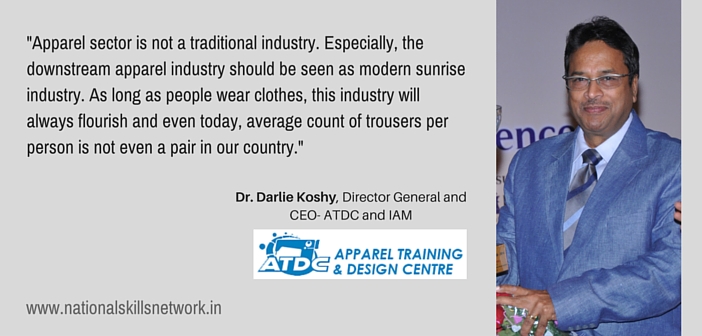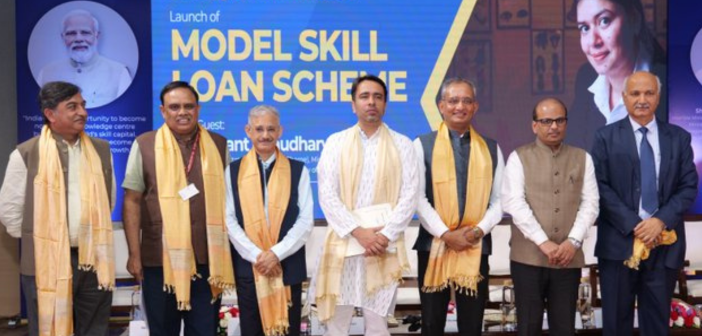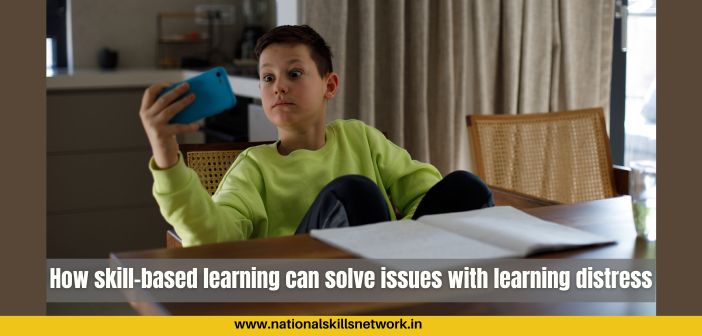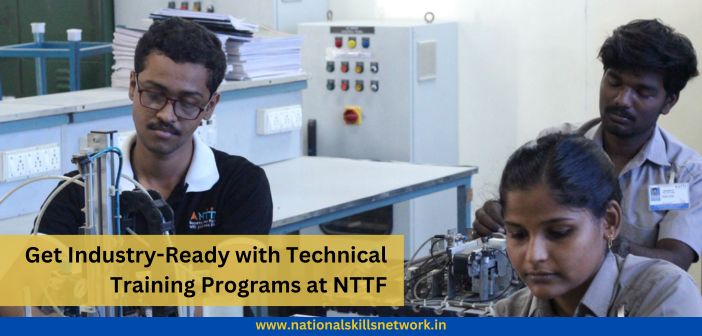The apparel sector needs thousands of trained workforce to meet the growing demands of a vibrant industry. Apparel Training & Design Centre (ATDC), India’s largest vocational training network in this sector, has positively impacted people with skills and jobs across the country. This Skill Talk by Dr. Darlie Koshy, Director General and CEO- ATDC and IAM, unravels several actionable points that can enhance the aspirational value of careers in this sector by taking into consideration the socioeconomic and cultural aspects of India. Read on to know more about how aspirational nomenclature can transform the perception and social value of a profession.
Opportunities and prospects
If you look at textile and apparel industry as traditional industry, then your growth would be caught in a time warp and you lose opportunities. Instead, if this age old industry can now be seen in the context of Global Fashion and Lifestyle, at Apparel Training Design Center, we are looking at enormous opportunities for growth and employment generation.
The domestic industry is expected to require 27 lakh additional people per year. From the current level, if it goes to 229 million by 2022 which is very likely, with the economic growth of 7.6% now, 27 lakh skilled workforce are required to take care of that growth. 10% of that will be always managers and designers and 90% below that will be inline quality controllers, embroiderers, block printers, pattern makers, sewing machine operators and so on. 80% women who work in this sector, find this career very suitable; they don’t want to go too far and work, there are small cottage industries coming up for e-commerce, making small groups of people working on products or they can work from home with many value addition techniques.
 Making vocational education aspirational by changing nomenclature
Making vocational education aspirational by changing nomenclature
Initially, attracting students in apparel training domain was a tough challenge; when I joined NIFT in 1987, I asked them if the institute name should be named National Institute of Tailoring Technology, they would go aghast if you mention the word tailoring even though it is the base for fashion!
It is good to see the change today. Beauticians work in saloons as specialists and carpenters have turned into interior designers – the whole perception changes, we accept them as socially upward moving people. This is one of the ways to make vocational education aspirational by giving it an aspirational nomenclature in the changing ecosystem of that program. Tailoring shops become boutiques and shoemakers could be called as custom shoe designers. While the government has done lot of good work, the MSDE needs to have some sociologists and educationists to re-look at the nomenclature of hundreds of courses in the country.
For example, today nutritionist is a respected profession and it is not considered anything below a doctor. So you need to change the perception around many of the vocational manual professions to something more important. As I had mentioned in one of my earlier interviews, if only the government had set up a crafts university along with agriculture universities in 1950, we could have given a B.Tech to a weaver or a designer and that would have changed them to stay alive in these industries, we did not do that and therefore 1000s of ‘karigars’ abandoned the industry.
ATDC has now about 190 centres in 23 states including one each in Sikkim and Manipur, 100 cities and 125 districts. ATDC centers have trained 186000 candidates under ISDS so far, and will cross 200000 by October 2016.
Training and mobilization challenges
Simply training at the lowest level and following standard nomenclature and curriculum will not make a radical difference in vocational education. Another important aspect is the geographical mismatch between training and jobs. And salaries go a long way in making vocational education aspirational.
Today, the National Occupational Standards (NOS) or the job profiles are too narrow. We need to understand that in a context like India, multi-skilling and multitasking is as important in development as it was in engineering and management few years ago. For example, if a driver is working with an CEO of a company, he is asked to do many odd jobs, like delivering an important letter to someone or getting a license renewed, so he is presentable, he speaks English. The skill training today is too narrow, every skill sector is writing about 45 job roles, some of them are so narrowly defined that you do not find a point in hiring a person just for that job. You require a broader job role.
Mobilization is the biggest challenge now because we are training people where jobs are not available! For example, I am told that, every day in Tirupur railway station, each train brings hundreds people who come for jobs from Orissa, Bihar and other states where there is no apparel industry. If we are able to connect the habitat like in Sri Lanka, decongesting the industry from Colombo and other places, the apparel industry grew and so did the jobs. Today, we are not able to do that in India because, training is happening but there are no jobs in that place. To overcome migration issues, you need to really look at where the jobs are and what are the institutions in that area which can then train people according to job availability.
Multi-skilling for informal sector
Informal sector and MSME sector generate about 75% jobs in the country. It is not the organized sector that is creating the jobs, because they are getting more automated with advanced manufacturing techniques and even robotics displacing jobs and hence strengthening SMEs in the informal sector has become the need of the hour. For example, in a logistics company in Nagpur, after automation, they lost 50% of the jobs. With the pace at which automation is happening, the government has to encourage informal sector where most jobs get created. And, this sector needs more multi skilled people. When they take one person, they expect that person to do 3 or 4 jobs.
The difference between world skill parameters and Indian skills is very huge and therefore, it is important that you look at the training needs in a different context, because now we are not in an industry that can look 25 years back. If required, we must have long term programs, not just for 150 hours. The new norms do provide for that and at ATDC we train about 7000 to 10000 people in long term programs and 35000 people in short term programs. I strongly feel between the age of 18 and 25 they must have three opportunities for training.
In India, 20 out of 100 people see the door of a university, and 80 people do not have the chance and for such people a B.Voc program is a big move, they get social respectability and their quality of life changes for good. Knowledge and skills should exist together. Knowledge should be the back end and skills should be the front end, earlier it was the opposite, today the world has changed, any job looks for skills supporting the profession. So, it requires various kinds of skills, and the government needs to be cognizant and give parallel schemes where all types of industries are respected. This will happen eventually.
Policy advocacy and implementation
National board of accreditation and certification is a must. Every skill sector giving the certificate – I am not a believer of that. If you want to train Indian workforce, it should be like a national skill exam and you are given a rank and a placement. The government scheme is such that, only the people who passed get money, and 95% people are passed by the assessment agency. Along with it, self-employment and entrepreneurship are absolutely important, the economic policy and skill policy need to work together. China is a good example of how these policies are aligned. Perhaps, we need to look at success stories from other countries and adopt some best practices to continued impact on creating livelihoods and careers.













Y.K.GUPTA : 17TH JULY,2016
I am lucky that I had many occasions to meet Dr Koshy. I always found him in discussions with new/modern ideas having true focus on the elevation of the skill development amongst the masses who do not have opportunity to develop skill. I really appreciate his efforts and the idea to change the nomenclature in various vocational courses.
wishing him and his team all the best
Dr. Koshy has really brought the anomalies in the nomenclature that impact the aspirations of the 80% youth. Time has come for the government to go beyond literacy alone for employment. Emphasis must be given by to recognise skill standards and certification for employment in the industry. Perhaps an amendment to the Labour Act that makes it incumbent on the industry to hire skilled certified workforce